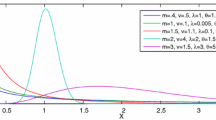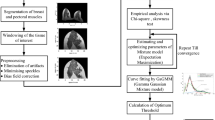Abstract
A major issue in characterization of clinical Ultrasound B-mode images has been to identify a few probability distributions which can broadly classify images of human organs. This paper precisely addresses the concern by resorting to statistical characterization of gray levels in 100 clinical B-mode ultrasound kidney images. A detailed investigation of central and peripheral kidney regions is carried out. Pearson family of distributions is employed as a means to model the images and to provide analytical expression of the suitable pdf in terms of the parameter \(\kappa \). In majority of cases, it is noted that type I Pearson distribution (corresponding to negative \(\kappa \)) yields the best fit. For testing the efficacy of Pearson family of distributions in relation to commonly used probability distributions viz. Nakagami, Inverse Gaussian, Gamma, and Weibull, performance measures based on Jensen–Shannon divergence and Kolmogorov–Smirnov test statistics are used. The statistical analysis reveals that Pearson family of distributions outperforms which is evident through cumulative ranking of probability distributions considered in the study. This study attempts to identify the Pearson types which can universally characterize the clinical US B-mode images of different human organs.

















Similar content being viewed by others
References
Agarwal, R., Karmeshu: Ultrasonic backscattering in tissue: characterization through Nakagami-generalized inverse Gaussian distribution. Comput. Biol. Med. 37(2), 166–172 (2007)
Bouhlel, N., Sevestre-Ghalila, S.: Nakagami Markov random field as texture model for ultrasound RF envelope image. Comput. Biol. Med. 39(6), 535–544 (2009)
Delignon, Y., Pieczynski, W.: Modeling non-Rayleigh speckle distribution in SAR images. IEEE Trans. Geosci. Remote Sens. 40(6), 1430–1435 (2002)
Destrempes, F., Meunier, J., Giroux, M.F., Soulez, G., Cloutier, G.: Segmentation in ultrasonic B-mode images of healthy carotid arteries using mixtures of Nakagami distributions and stochastic optimization. IEEE Trans. Med. Imaging 28(2), 215–228 (2009)
Doane, D.P.: Aesthetic frequency classification. Am. Stat. 30(4), 181–183 (1976)
Elderton, W.P., Johnson, N.L.: System of Frequency Curves. Cambridge University Press, London (1969)
Eltoft, T.: The Rician inverse Gaussian distribution: a new model for non-Rayleigh signal amplitude statistics. IEEE Trans. Image Process. 14, 1722–1735 (2005)
Eltoft, T.: Modeling the amplitude statistics of ultrasonic images. IEEE Trans. Med. Imaging 25, 229–240 (2006)
Gentle, J.A.: Computational Statistics. Springer, Germany (2009)
Gupta, A., Karmeshu: Statistical characterisation of speckle in clinical echocardiographic images with Pearson family of distributions. Def. Sci. J. 61(5), 473–478 (2011)
Jakeman, E.: K distributed noise. J. Opt. A Pure Appl. Opt. 1, 784–789 (1999)
Johnson, N.L., Kotz, S., Balakrishnan, N.: Continuous Univariate Distributions, vol. 1. Wiley, Canada (1994)
Karmeshu, Agarwal, R.: Study of ultrasonic echo envelope based on Nakagami inverse Gaussian disribution. Ultrasound Med. Biol. 32(3), 371–376 (2006)
Karmeshu: Entropy measures, maximum entropy principle and emerging applications. Springer, Germany (2003)
Ketchantang, W., Derrode, S., Martin, L., Bourennane, S.: Pearson-based mixture model for color object tracking. Mach. Vis. Appl. 19, 457–466 (2008)
Kwan, R., Leung, C.: On the applicability of the Pearson method for approximating distributions in wireless communications. IEEE Trans. Commun. 55(11), 2065–2069 (2007)
Lin, J.: Divergence measures based on the Shannon entropy. IEEE Trans. Inf. Theory 37(1), 145–151 (1991)
Massey, J.F.: The Kolmogorov–Smirnov test for goodness of fit. J. Am. Stat. Assoc. 46(253), 68–78 (1951)
Nie, H., Chen, S.: Lognormal sum approximation with type IV Pearson distribution. IEEE Commun. Lett. 11, 790–792 (2007)
Nillesen, M.N., Lopata, R.G.P., Gerrits, I.H., Kapusta, L., Thijssen, J.M., Korte, C.D.: Modeling envelope statistics of blood and myocardium for segmentation of echocardiographic images. Ultrasound Med. Biol. 34(4), 674–680 (2008)
Raju, B.I., Srinivasan, M.A.: Statistics of envelope of high-frequency ultrasonic backscatter from human skin in vivo. IEEE Trans. Ultrason. Ferroelectr. Freq. Control 49, 871–882 (2002)
Raju, B.I., Swindells, K.J., Gonzales, S., Srinivasan, M.A.: Quantitative ultrasonic methods for characterization of skin lesions in vivo. Ultrasound Med. Biol. 29, 825–838 (2003)
Renzo, M.D., Graziosi, F., Santucci, F.: Approximating the linear combination of log-normal RVs via Pearson type IV distribution for UWB performance analysis. IEEE Trans. Commun. 57(2), 388–403 (2009)
Roy, L.K.: An extension of the Pearson systems of frequency curves. Trabajos de Estadstica Investigacin Operativa 22, 113–123 (1971)
Shankar, P.M.: A general statistical model for ultrasonic backscattering from tissues. IEEE Trans. Ultrason. Ferroelectr. Freq. Control 47(3), 727–736 (2000)
Shankar, P.M.: Ultrasonic tissue characterization using a generalized Nakagami model. IEEE Trans. Ultrason. Ferroelectr. Freq. Control 48(6), 1716–1720 (2001)
Shankar, P.M.: A compound scattering pdf for the ultrasonic echo envelope and its relationship to K and Nakagami distributions. IEEE Trans. Ultrason. Ferroelectr. Freq. Control 50, 339–343 (2003)
Shankar, P.M.: The use of compound probability density function in ultrasound tissue characterization. Phys. Med. Biol. 49, 1007–1015 (2004)
Shankar, P.M., Reid, J.M., Ortega, H., Piccoli, C.W., Goldberg, B.B.: Use of non-Rayleigh statistics for the identification of tumors in ultrasonic B-scans of the breast. IEEE Trans. Med. Imaging 12(4), 687–692 (1993)
Shankar, P.M., Dumane, V.A., Reid, J.M., Genis, V., Forsberg, F., Piccoli, C.W., Goldberg, B.B.: Classification of ultrasonic B-mode images of breast masses using Nakagami distribution. IEEE Trans. Ultrason. Ferroelectr. Freq. Control 48(2), 569–580 (2001)
Shankar, P.M., Forsberg, F., Lown, L.: Statistical modeling of atherosclerotic plaque in carotid Bmode imagesa feasibility study. Ultrasound Med. Biol. 29, 1305–1309 (2003)
Tao, Z., Tagare, H.D., Beaty, J.D.: Evaluation of four probability distribution models for speckle in clinical cardiac ultrasound mages. IEEE Trans. Med. Imaging 25(11), 1483–1491 (2006)
Tsui, P.H., Wang, S.H., Huang, C.C.: The effect of logarithmic compression on estimation of the Nakagami parameter for ultrasonic tissue characterization: a simulation study. Phys. Med. Biol. 50, 3235–3244 (2005)
Wagner, R.F., Smith, S.W., Sandrik, J.M., Lopez, H.: Statistics of speckle in ultrasound B-scans. IEEE Trans. Sonics Ultrason. 30(3), 156–163 (1983)
York, G., Kim, Y.: Ultrasound processing and computing: review and future directions. Annu. Rev. Biomed. Eng. 1, 559–588 (1999)
Zhang, Q.T., Song, S.H.: A systematic procedure for accurately approximating lognormal-sum distributions. IEEE Trans. Veh. Technol. 57(1), 663–666 (2008)
Acknowledgments
The authors are thankful to the reviewers for their valuable suggestions and comments, which led to significant improvement in the paper. The first author acknowledges and thanks Dr. Yogesh Sharma, Radiologist and Sonologist, Noida Diagnostics Centre, Noida, UP, India, for providing US images and his institute for approving the experimental protocol.
Author information
Authors and Affiliations
Corresponding author
Rights and permissions
About this article
Cite this article
Gupta, A., Karmeshu Efficacy of Pearson distributions for characterization of gray levels in clinical ultrasound kidney images. SIViP 9, 1317–1334 (2015). https://doi.org/10.1007/s11760-013-0578-3
Received:
Revised:
Accepted:
Published:
Issue Date:
DOI: https://doi.org/10.1007/s11760-013-0578-3




